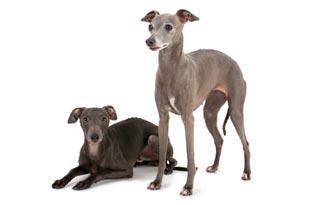Can Dogs See Color? https://investorshangout.c
Post# of 63897

When you walk down the street with your dog, the almost endless array of hues you see -- from the brilliant blue sky and lush green grass to an ordinary red stop sign -- appears much differently to your pet.
Dogs have just one-tenth the concentration of color-capturing cones in the back of their eyes that humans have. So while we enjoy a smorgasbord of tinges and tones, dogs only see two colors: blue-violet and yellow, as well as any blends of these colors. The rest of their world appears in shades of gray like a dreary winter's day.
"Restrictions in color vision are probably of limited consequence in dogs, as it is likely that dogs react only to colors of biological importance to them," veterinarians Christopher Murphy and Paul Miller wrote in their 1995 study about canine vision, published in the journal of the American Veterinary Medical Association. Basically, since dogs don't forage for brightly-colored fruits like apples and oranges, there isn't a lot of value in seeing those colors, explains Miller, compared to being able to break the camouflage of prey or seeing potential threats.

Knowledge that a dog's world appears in more than just black or white came in 1989, when researchers at the University of California in Santa Barbara examined the color vision of three dogs -- two Italian greyhounds and a toy poodle -- in a series of behavioral discrimination experiments. Their findings indicated that there are color-sensitive cones in the dog's retina, located in the back of the eyeball. Later, these findings were confirmed through an electroretinography, a test similar to an electrocardiogram except that it measures the eye's response to light.
Dogs, like most mammals, are dichromats -- possesing two types of cones in their retina for color perception and ability to see details. Humans, on the other-hand, are trichromatic. Their eyes contain three types of light-sensitive cones -- blue-, green- and red-sensitive -- which allows enjoyment of all colors in the visible spectrum.

Interestingly, dogs see colors the way people with red-green color blindness see colors, explains Gregory Acland, a professor of medical genetics at Cornell University's College of Veterinary Medicine in Ithaca, N.Y. This rare disorder usually occurs in males and accounts for about 4 percent of the population.
"Such people will tell you that they do in fact see colors but they can have difficulties distinguishing some shades that other people tell apart easily," he explains. "Typically the colors they have trouble distinguishing are pastels or muddy shades in the red-orange-green range."
"Evolutionarily, this is because all mammals descend from crepuscular shrewlike creatures with eyes not adapted for daylight vision or color contrast," explains Acland. "The retinas of birds, reptiles and fishes have much more elaborate receptors for detecting color contrasts."
Through gene therapy, it's feasible to give a dog trichromatic vision, just like ours, but nobody has done that yet, Acland said.

Of course, a dog's strong suit is his sense of smell. This is a good thing, according to researchers Miller and Murphy, since compared to people -- who rely heavily on sight -- the canine's visual system is inferior in a number of ways, including depth perception, range of color and visual acuity. However, dogs trump humans in other aspects, such as motion sensitivity, the ability to see in low lighting and differentiating between shades of gray.
This has made the dog a more efficient predator in certain environmental situations (for example, in the dark) and permits him or her to "exploit an ecological niche inaccessible to humans," researchers Miller and Murphy conclude.
 (0)
(0) (0)
(0)